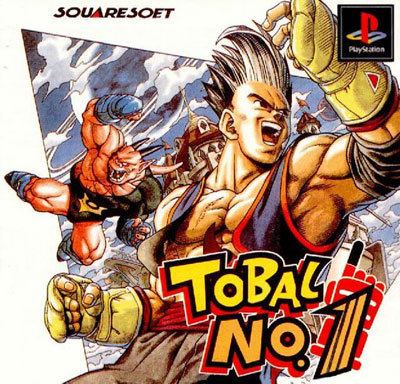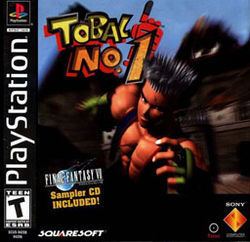8.8 /10 1 Votes
8.7/10 IGN Producer(s) Koji Yamashita Initial release date 2 August 1996 Genre Fighting game | 4.4/5 Emuparadise Director(s) Seiichi Ishii Artist(s) Akira Toriyama Developer Dream Factory Platform PlayStation | |||||||||||||||||||||||||||||||||
 | ||||||||||||||||||||||||||||||||||
Distributor(s) Sony Interactive Entertainment Composer(s) Masashi Hamauzu
Kenji Ito
Yasuhiro Kawakami
Noriko Matsueda
Yasunori Mitsuda
Junya Nakano
Ryuji Sasai
Yoko Shimomura Mode(s) Single-player, multiplayer Designers Akira Toriyama, Seiichi Ishii Publishers Square, Sony Interactive Entertainment Similar Square games, Fighting games | ||||||||||||||||||||||||||||||||||
Tobal no 1 game sample playstation
Tobal No. 1 (トバル ナンバーワン, Tobaru Nanbā Wan) is a fighting video game for the PlayStation developed by DreamFactory and published by Square in 1996. The game was DreamFactory's first release, as well as Square's first release on the CD-based console.
Contents
- Tobal no 1 game sample playstation
- Tobal no 1 psx intro
- Gameplay
- Plot
- Characters
- Music
- Reception and legacy
- References

Tobal No. 1 marks Square's incursion into the fighting game genre, although an adventure-like quest mode is part of the game. The game's mechanics were designed with the aid of fighter game designer Seiichi Ishii, while all the characters were designed by Akira Toriyama of Dragon Ball fame. The sequel, Tobal 2, was never released in North America and Europe.

Packaged with both the North American and Japanese version of the game was a sampler disc featuring a pre-release demo of Final Fantasy VII and video previews of Final Fantasy Tactics, Bushido Blade, and SaGa Frontier.

Tobal no 1 psx intro
Gameplay

Tobal No. 1 has various gameplay modes including a tournament mode, two player versus mode, practice mode, and the unique quest mode, all of which utilize the same fighting system. The game itself runs at up to a smooth 60 frames per second due to its lack of textured polygons and reduced details which gave the game a distinctive look in comparison to other fighting games at the time, such as Tekken 2. The game's controls are unique in that they allow full freedom of movement in the ring as long as the player faces the opponent. The player has the ability to dash and jump, and certain buttons execute high, medium, and low attacks for each character. Tobal No. 1 also has a unique grappling and blocking system, offering the player a variety of throws and counter moves.
Perhaps the most distinctive feature of Tobal No. 1 is the "Quest Mode", which combines the game's fighting controls with three-dimensional dungeon exploration. The player must advance down a number of floors, contend with traps, and engage in fights with a variety of enemies including the game's playable characters. Several items can be found, dropped by enemies, or bought using crystals. These items can be picked up, consumed, or thrown at enemies, and include foodstuffs that can restore the player's HP or potions that have a range of effects including raising the player's maximum health or bringing it down to 1 point. There is no way to save one's progress, and dying means starting over from the beginning. Defeating certain characters in this mode unlocks them as playable characters in the game's other modes.
Plot
Tobal No. 1 takes place in the year 2027 on a fictional planet called Tobal, which has large deposits of Molmoran, an ore that can be used as an energy source. The planet's 98th tournament is held to determine who has the rights to the ore. A number of humans and aliens compete for the title. The game's plot and character backstories are only explored in the instruction manual. All of the initial eight playable characters receive the same ending.
The game's immediately playable characters include Chuji Wu, Oliems, Epon, Hom, Fei Pusu, Mary Ivonskaya, Ill Goga, and Gren Kutz. Bosses include Nork, Mufu, and the emperor Udan. All bosses are unlockable after defeating them in Dungeon Mode except Nork. Instead, the game allows the player to select Snork (Small Nork), a pint-sized version of the very large character. There is also one secret fighter named Toriyama Robo (named for Akira Toriyama) who is unlockable if the player can complete the 30-floor Udan's Dungeon level in the quest mode. Toriyama Robo is not seen at any point in the game except at the very end of the dungeon.
Characters
Music
The music in Tobal No. 1 was composed by eight of Square's composers: Yasunori Mitsuda, Yasuhiro Kawakami, Ryuji Sasai, Masashi Hamauzu, Junya Nakano, Kenji Ito, Noriko Matsueda, and Yoko Shimomura. Unlike the common themes of techno and rock found in other fighting games, Tobal No. 1 contains a complete mixture of sound, varying instrumental and electronic music, with styles ranging in hip hop, ambient, 1980s groove, jazz, and Latino, attributed to the diversity of the composers' styles. The soundtrack was released by DigiCube in Japan on August 21, 1996 and contains 21 tracks found in the game, including one unreleased track. The album was arranged by GUIDO, who later released their own 7-track remix disc, Tobal No. 1 Remixes Electrical Indian.
Tobal No. 1 Original Sound Track
Reception and legacy
Tobal No. 1 sold in excess of 650,000 copies in Japan the year it was released. It is sometimes cited that the game enjoyed such healthy sales as a result of the Final Fantasy VII demo disc inclusion, a highly anticipated title at the time. However, the game is cited as a cult hit in North America, although it apparently did not sell as well.
IGN noted the game's unique graphical representation and free-ranging controls—it ran at 60 frames per second and in 640x480 resolution. In 2004, the website rated the game as one of twelve games that deserves a follow-up on the PlayStation 2. GameSpot admired the variety of fighting styles in the game's normal mode, but found the same controls worked sluggishly in the game's unique Quest Mode. Game Revolution found the blocking system to be confusing but called the game's quest mode the "most innovative feature since—well, bosses."
The game's sequel, Tobal 2, was released in 1997 for the PlayStation, but was exclusive to Japan. A mobile phone incarnation, titled Tobal M, was released in Japan on December 12, 2007.
